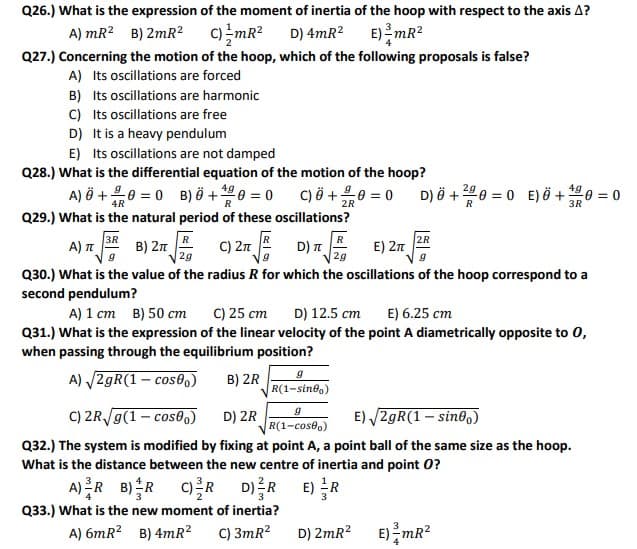Q29.) What is the natural period of these oscillations? 3R R B) 2n 29 C) 2n 2R E) 2n R A) T D) T 2g Q30.) What is the value of the radius R for which the oscillations of the hoop correspond to a second pendulum? A) 1 cm B) 50 cm C) 25 cm E) 6.25 cm D) 12.5 cm Q31.) What is the expression of the linear velocity of the point A diametrically opposite to 0, when passing through the equilibrium position? A) /2gR(1 – cos0) B) 2R R(1-sineo) C) 2R/g(1– cos®.) D) 2R E) /2gR(1– sin0) R(1-cose,)
Q29.) What is the natural period of these oscillations? 3R R B) 2n 29 C) 2n 2R E) 2n R A) T D) T 2g Q30.) What is the value of the radius R for which the oscillations of the hoop correspond to a second pendulum? A) 1 cm B) 50 cm C) 25 cm E) 6.25 cm D) 12.5 cm Q31.) What is the expression of the linear velocity of the point A diametrically opposite to 0, when passing through the equilibrium position? A) /2gR(1 – cos0) B) 2R R(1-sineo) C) 2R/g(1– cos®.) D) 2R E) /2gR(1– sin0) R(1-cose,)
Physics for Scientists and Engineers: Foundations and Connections
1st Edition
ISBN:9781133939146
Author:Katz, Debora M.
Publisher:Katz, Debora M.
Chapter13: Rotation Ii: A Conservation Approach
Section: Chapter Questions
Problem 7PQ: A 12.0-kg solid sphere of radius 1.50 m is being rotated by applying a constant tangential force of...
Related questions
Question
Show all working explaining detailly each step.
Answer should be type written using a computer Keyboard!
Answer Q29, 30, 31

Transcribed Image Text:Q26.) What is the expression of the moment of inertia of the hoop with respect to the axis A?
A) mR? B) 2mR2 C)mR?
D) 4mR? E)mR²
Q27.) Concerning the motion of the hoop, which of the following proposals is false?
A) Its oscillations are forced
B) Its oscillations are harmonic
C) Its oscillations are free
D) It is a heavy pendulum
E) Its oscillations are not damped
Q28.) What is the differential equation of the motion of the hoop?
A) ò +유0=0 B)6+400=0
C) Ö +0 = 0
D) Ö +200 = 0 E) Ö + 0 = 0
4R
R
2R
3R
Q29.) What is the natural period of these oscillations?
3R
B) 2n
R
R
D) n
2g
2R
A) T
C) 27
E) 2n
2g
Q30.) What is the value of the radius R for which the oscillations of the hoop correspond to a
second pendulum?
A) 1 cm B) 50 cm
C) 25 cm
D) 12.5 cm
E) 6.25 cm
Q31.) What is the expression of the linear velocity of the point A diametrically opposite to 0,
when passing through the equilibrium position?
A) /2gR(1 – cos0)
B) 2R
R(1-sinea)
C) 2R/g(1 – cos0)
D) 2R
E) /2gR(1 – sin0,)
R(1-cose.)
Q32.) The system is modified by fixing at point A, a point ball of the same size as the hoop.
What is the distance between the new centre of inertia and point 0?
A)R B)R 이를R D)를R E)R
Q33.) What is the new moment of inertia?
A) 6mR? B) 4mR?
C) 3mR?
D) 2mR? E) mR2

Transcribed Image Text:A homogenous hoop of mass m and radius R is suspended in 0, to a horizontal axis A perpendicular
to the plane of the hoop. It is moved away from the equilibrium position to an angle 0, and then
released without initial velocity.
The position of the hoop is located by an angle 0 between OG and the vertical (OG being the center
of inertia of the hoop). Neglecting all the frictional forces.
Expert Solution
This question has been solved!
Explore an expertly crafted, step-by-step solution for a thorough understanding of key concepts.
Step by step
Solved in 2 steps

Knowledge Booster
Learn more about
Need a deep-dive on the concept behind this application? Look no further. Learn more about this topic, physics and related others by exploring similar questions and additional content below.Recommended textbooks for you

Physics for Scientists and Engineers: Foundations…
Physics
ISBN:
9781133939146
Author:
Katz, Debora M.
Publisher:
Cengage Learning

University Physics Volume 1
Physics
ISBN:
9781938168277
Author:
William Moebs, Samuel J. Ling, Jeff Sanny
Publisher:
OpenStax - Rice University

Classical Dynamics of Particles and Systems
Physics
ISBN:
9780534408961
Author:
Stephen T. Thornton, Jerry B. Marion
Publisher:
Cengage Learning

Physics for Scientists and Engineers: Foundations…
Physics
ISBN:
9781133939146
Author:
Katz, Debora M.
Publisher:
Cengage Learning

University Physics Volume 1
Physics
ISBN:
9781938168277
Author:
William Moebs, Samuel J. Ling, Jeff Sanny
Publisher:
OpenStax - Rice University

Classical Dynamics of Particles and Systems
Physics
ISBN:
9780534408961
Author:
Stephen T. Thornton, Jerry B. Marion
Publisher:
Cengage Learning

Principles of Physics: A Calculus-Based Text
Physics
ISBN:
9781133104261
Author:
Raymond A. Serway, John W. Jewett
Publisher:
Cengage Learning

Physics for Scientists and Engineers, Technology …
Physics
ISBN:
9781305116399
Author:
Raymond A. Serway, John W. Jewett
Publisher:
Cengage Learning

Glencoe Physics: Principles and Problems, Student…
Physics
ISBN:
9780078807213
Author:
Paul W. Zitzewitz
Publisher:
Glencoe/McGraw-Hill